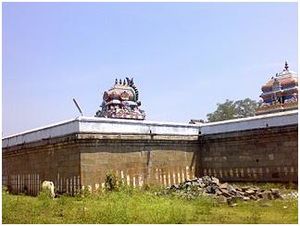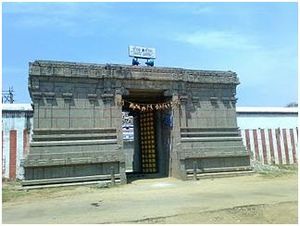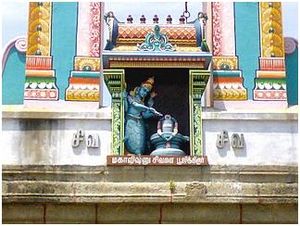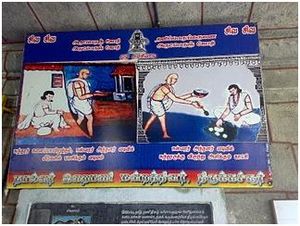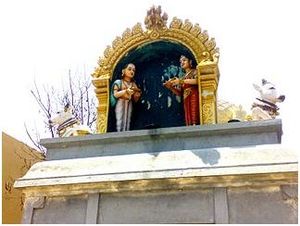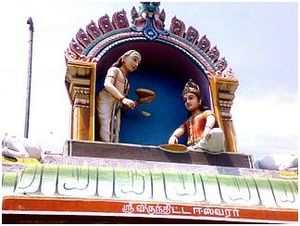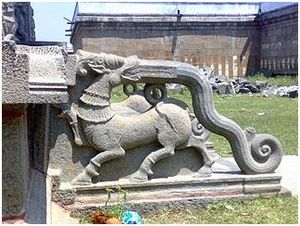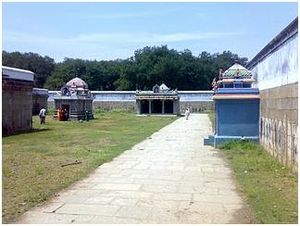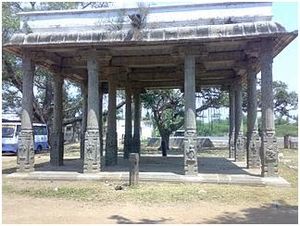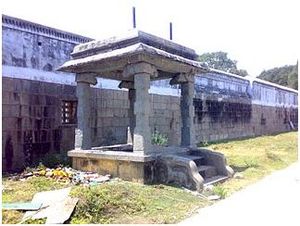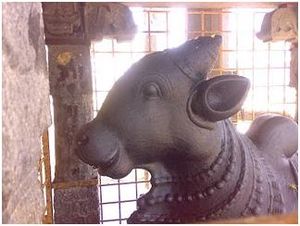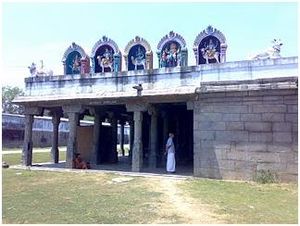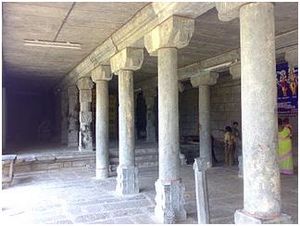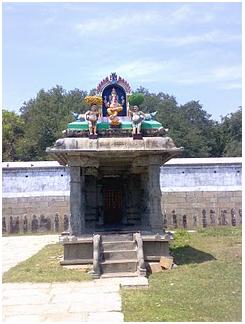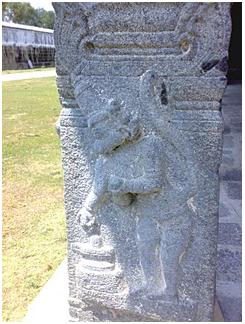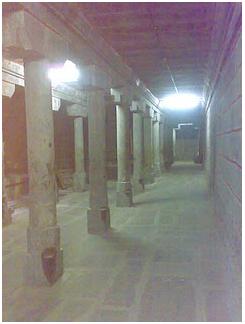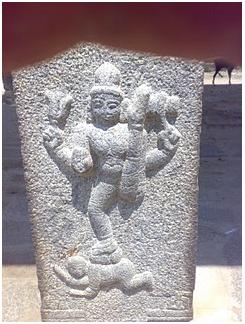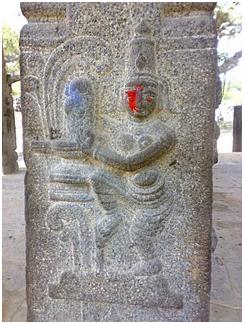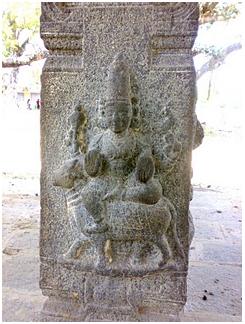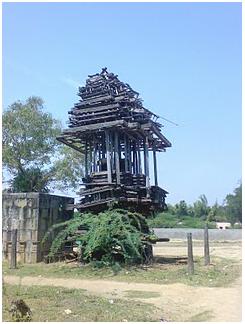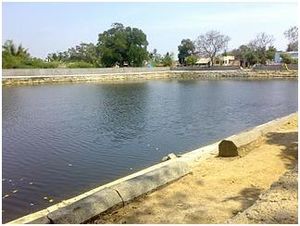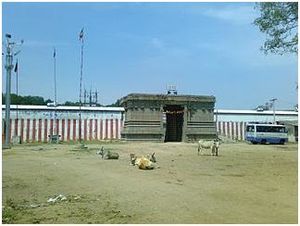Thirukkachur Sri Kachabeswarar
Thirukkachur is a very small village situated about 3 kms from Singaperumal Koil. This village lies of the west side of Singaperumal Koil off the GST Road. This small village is blessed with a huge temple for Lord Shiva called Kachabeswarar temple. The main deity here is Sri Kachabeswarar and Goddess Sri Anjanaakshi Ambaal. Legend has it that while Devas and Asuras churned Paarkadal (the Mighty Ocean), Sri Aadhiseshan and a hill called Mandara Malai (மந்தர மலை) were used. To avoid the hill from sinking into the ocean, Lord Vishnu took the Avatar of a Tortoise (Koorma Avatar) on whose back (shell) the hill can rest while churning.
While he took this Avatar, He came and prayed Lord Shiva at this place, to give Him the strength to withstand the hill on His shell, till the churning is complete. Lord Shiva blessed Lord Vishnu in this place with the strength to withstand the weight of the hill. In Sanskrit, Kachaba means Tortoise. As Lord Vishnu prayed Lord Shiva in the form of Tortoise, Lord Shiva here came to be known as Sri Kachabeswarar. Also this village got its name after this legend, as Thirukkachur.
The temple has another wonderful history behind it. Sri Sundaramurthy Naayanaar, who is one among the Naalvar, wanted to visit Sri Kachabeswarar here and had come by walk to this temple. When he reached the temple, it was noon time. Sri Sundarar sat in the temple and was too hungry. Lord Shiva, not wanting to see His devotee suffering from hunger, appeared as an elderly Brahmin man and went to the houses of the village for Bhiksha (alms). To mark this incident, there is another small temple inside this village with a Shiva Lingam, where the Lord is called as Irandhiteeswarar (இரந்திட்டீஸ்வரர்). In Thamizh ‘Irandhu’ means ‘asking for alms’.
After collecting Bhiksha from various streets of the village, Lord Shiva came to Sri Sundarar and fed him with the food he got as Bhiksha. This is the only place where the Lord Himself performed Bhiksha to feed His devotee. Hence the Lord here is also called as ‘Virundhitteeswarar’ (விருந்திட்டீஸ்வரர்). Virundhu means ‘feast’ in Thamizh. There is a separate shrine for ‘Virundhitteeswarar’ at the northern Praakaaram of this temple. Sri Sundarar has composed 10 songs on the Lord here. Though the main deity of this temple is Sri Kachabeswarar, this temple is popularly known as Sri Thyagaraja Swamy Temple. Sri Thyagarajar is the Urchavar here, who is in the form of Somaskandhar {Shiva, Uma (Parvathi) and Skandhar (Muruga) together}.
On the outer Praakaaram, Lord Vinayagar has a separate shrine at the south west side of the temple and is called as Sri Gnana Vinayagar. Lord Vinayagar shrine is made beautifully with excellent carvings on pillars and along the side of the steps.
Lord Muruga with Sri Valli, Sri Devayanai and Sri Bhairavar has separate shrines at the northern part of the temple. There is a beautiful Stone Mandapam at the South side of the temple, which is used during Urchavams. A grand Nandhi is seen at the eastern side near Dwajasthambham facing the sanctum. In front of Sri Thyagaraja Swamy shrine, there is a beautiful Stone Mandapam having 27 pillars with lovely carvings on them. This is called as Nakshathra Mandapam as these 27 pillars denote 27 stars. One of the pillars have the depiction of Lord Vishnu as Tortoise worshipping Lord Shiva. Another pillar has Sri Anjaneyar worshipping Lord Shiva, with flower on His right hand and a Pooja bell on his left hand.
After crossing this Mandapam, Ambaal shrine is seen, where Sri Anjanaakshi Ambaal is facing south. Sri Ambaal is tall and beautiful with wonderful grace on her face. Through another entrance towards east, the main sanctum is reached. Appar, Sundarar, Sambandhar and Maanickavaasagar (the Naalvar) are seen praying the Lord outside the sanctum on the left. The sanctum is beautifully constructed with a Maha Mandapam having number of strong pillars. The entire stone structure had remained undisturbed for centuries. The entire place around the sanctum is so calm and cool. The main deity Sri Kachabeswarar is in the form of Shiva Lingam, which is said to be ‘Swayambhu’ (self evolved).
Around the Praakaaram of the sanctum, Lord Vinayagar and Sri Dhakshinamurthy are present facing the south. Sri Mahavishnu is present facing the west. Sri Brahma and Sri Durga are seen on the outer walls of sanctum facing north. There stands a 16 pillared stone Mandapam outside the temple on the eastern side, at a distance. All the pillars have exquisite carvings on them having both Saivite and Vaishnavite images, like Lord Vishnu, Lord Shiva’s Oordhuva Thaandavam, Goddess Kamakshi embracing Shiva Lingam, Lord Shiva on Rishaba Vaahana and many more. There is also a beautiful pond for this temple called ‘Koorma Theertham’, which is spread on a vast area and fully filled with water, giving a pleasant sight. The Sthala Viruksham for this temple is ‘Aala Maram’ (Banyan tree).
The Temple Chariot has a separate place (Theradi). But the Chariot is in dilapidated state, which makes the heart feel heavy.
Sivarathri and Pradhosham days are celebrated grandly at this temple. Brahmorchavam happens during the Thamizh month ‘Chithirai’. It is said that Lord Shiva (Urchavar) performs 18 forms of celestial dance (called Amirtha Thaandavam) during this festival, which is a boon to watch. This dance was believed to have performed by Lord Shiva as per the wish of Lord Vishnu, after the Gods churned out the Amirtham (celestial nectar) from the Paarkadal. Hence, this place had another name called “Nadana Vinodha Nallur’ in the past. ‘Nadana’ means dance in Thamizh. There is also another temple near the hill of this village called ‘Sri Marundheeswarar Temple’. A grand temple, a treasure in a small village.


